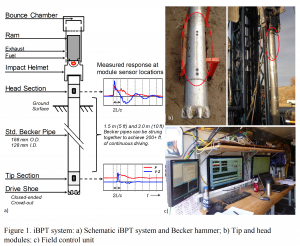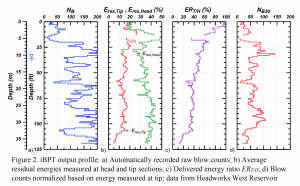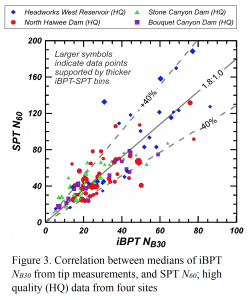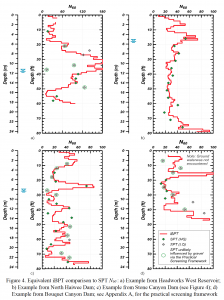Instrumented Becker Penetration Test
Overview
The Becker Penetration Test (BPT) is a widely used tool for characterizing gravelly soils, especially for liquefaction assessment. Interpretation of BPT data is complicated by the energy transferred from the hammer to the drill string being variable and by the shaft resistance that develops along the drill string generally increasing with penetration depth. Existing interpretation methods that utilize above-ground measurements to interpret BPT measurements have had limited success in accurately separating the shaft and tip resistance. Therefore, penetration resistance with depth cannot be reliably predicted.
The instrumented Becker Penetration Test (iBPT) directly measures the energy normalized penetration resistance of soil beneath the drill string tip. The equipment design goal of the iBPT was to obtain direct measurements of acceleration and force at the drill string tip using robust, reliable, low-maintenance equipment with commercial-level performance. Advances in sensor technology and the availability of robust, smaller, and faster data acquisition systems at a reasonable cost have only recently made the iBPT possible.
The iBPT system assembly is shown below. The central component is the modular instrumented pipe sections, which are 2 ft (61 cm) long with an outer diameter of 6.625 in (168 mm). Each instrumented section contains transducers for measurement of axial force and axial acceleration. The modular sections are assembled in series with standard 5 ft (1.52 m) and 10 ft (3.05 m) long Becker pipes, allowing the system to be deployed wherever Becker testing is available. The only additional operational step is connecting cables as pipe sections are added. Up to 100 ft of driving can be achieved in one day, including setting up and back filling of the hole with native material. Grouting can be done after retraction of the driving string.
Processing of the iBPT data produces a continuous profile of the average energy normalized penetration resistance (NB30) with depth. This provides three distinct advantages: (1) the measured values are reliable due to their direct measurement in situ eliminating the need to correct for shaft friction, (2) the average value presented is more representative than analysis of a single hammer blow at select depths, and (3) the continuous profile assists in defining the site stratigraphy.
Processing of more than 3000+ ft of iBPT data and 500+ SPT samples have produced the below correlation to estimate the equivalent SPT N60 values from iBPT NB30 data.
Example outputs from three different project sites are presented below.
Industry Project Experience
The iBPT has been successfully used for liquefaction assessment at five sites where presence of gravels limits the application of other penetration tests. The iBPT has also been used to characterize the penetration resistance of gravelly soils at two deep foundation sites. Site specific liquefaction assessment correlations have been developed and generalized correlations are being proposed as data is gathered from more sites.
Additional Reading
DeJong, J.T., Sturm, A., and Ghafghazi, M. “Characterization of Gravelly Alluvium”, 6th ICEGE Conference (keynote), Christchurch, New Zealand, 2015, 20 pp.
DeJong, J.T., Ghafghazi, M., Sturm, A.P., Wilson, D.W., den Dulk, J., Armstrong, R.J., Perez, A., and Davis, C.A. “Instrumented Becker Penetration Test, I: Equipment, Operation, and Performance”, ASCE J. Geotechnical and Geoenvironmental Engineering, 2017.
Ghafghazi M, DeJong JT, Sturm AP, Temple CE. “Instrumented Becker Penetration Test, II: iBPT- SPT Correlation for Liquefaction Assessment in Gravelly Soils”, ASCE J. Geotechnical and Geoenvironmental Engineering, 2017.
Note: additional references are available here.
Questions?
If you have additional questions about the iBPT, including potential use at a project site, please contact Jason DeJong.




